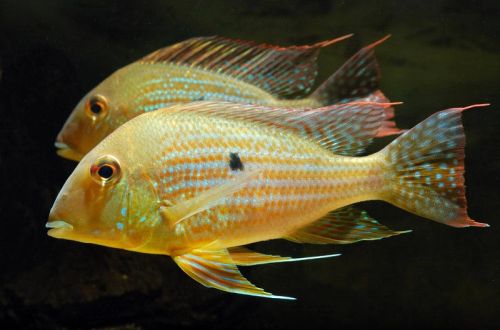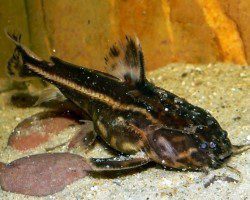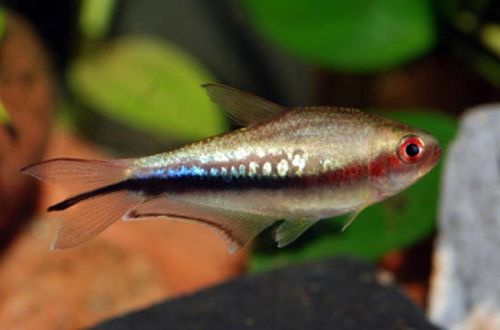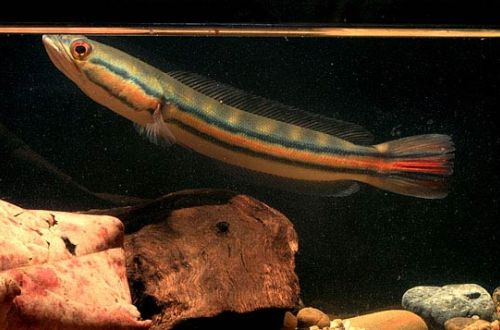
Red Snakehead
The red-striped or Red snakehead, scientific name Channa micropeltes, belongs to the family Channidae (Snakeheads). The fish has several commonly used names. Due to its size, it is also referred to as the Giant Snakehead, as well as the Indonesian Snakehead, after the area where it was first discovered by European explorers.

Contents
Habitat
The natural habitat extends throughout Southeast Asia – from the river systems of Laos and Thailand, to the islands of Indonesia, including the Greater Sunda Islands.
Inhabits the main channels of rivers, swamps, lakes and artificial ponds, reservoirs. Prefers deep areas of ponds with slow flow or stagnant water.
Description
Adult individuals reach impressive sizes and grow up to 130 cm and weigh up to 20 kg. The fish has a characteristic elongated serpentine body and a large head with a large mouth studded with sharp teeth.
Young fish are brightly colored. The fry are almost completely red. Grown up individuals acquire a pattern of two black narrow stripes, between which a wide red stripe passes. As they grow older, the pattern of lines disappears. The red pigment on the tail is the last to be lost.
Adult snakeheads are brown on the back and sides with a greenish pattern resembling water ripples. The belly is light silvery.
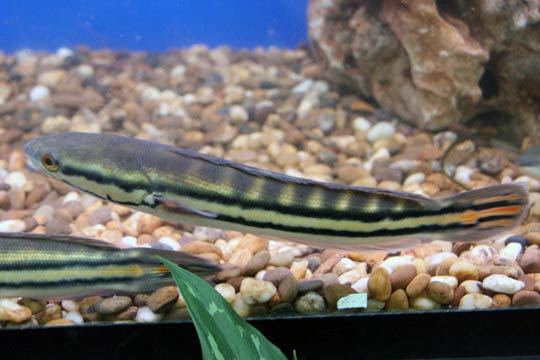
Representatives of the genus Channa have an adaptation to life in an unfavorable environment (drying water bodies, oxygen deficiency in water). They can breathe atmospheric air and stay out of water for a long time, provided that they are not exposed to direct sunlight, for example, they are hidden in mud, silt, and burrows. Able to crawl from one reservoir to another for short distances.
Behavior and Compatibility
Young fish live in large flocks. Having reached puberty, they begin to lead a solitary lifestyle and are aggressive towards relatives.
Being a predatory species, it is only compatible with fish of a similar size, which will not be perceived as food.
Brief information:
- The volume of the aquarium – from 1000 liters.
- Temperature – 20-30°C
- Value pH — 6.0–8.0
- Water hardness – 3–20 dGH
- Substrate type – any
- Lighting – subdued
- Brackish water – no
- Water movement is weak
- The size of the fish is up to 130 cm.
- Nutrition – live or fresh/frozen food
- Temperament – can be aggressive, quarrelsome
- Solitary content with other large species
Maintenance and care, arrangement of the aquarium
Red snakeheads are usually delivered at a young age before they have lost their bright coloration. A common mistake novice aquarists make is to place still small fish in relatively small aquariums without taking into account the maximum size of adults.
When the fish grows up, at the same time losing its bright body pattern, and it becomes crowded, the aquarist faces the question of what to do with it. Not infrequently, the solution is to release the Snakehead into the wild.
This irresponsible behavior has already led to the fact that the redbanded snakehead appeared in regions far from its natural habitat, including in North America. It did not take root everywhere due to the peculiarities of the climate, but in a number of areas it becomes an alpha predator, causing serious damage to the local ecosystem.
If you plan to purchase this type, then for long-term maintenance, you should definitely provide for a spacious tank of at least 1000 liters. A shaded aquarium with lots of hiding places from piles of rocks, driftwood and other decorative elements is recommended.
It is considered a hardy species, able to adapt to significant changes in its habitat. In the artificial environment, it can live in a wide range of pH and GH values. Not sensitive to the oxygen content in the water and the level of natural pollution (within reasonable limits).
A lid or similar protective device is a must when keeping a Redbanded Snakehead to prevent it from “escape” from the aquarium. Since the fish breathes atmospheric air, an air space must be left between the lid and the surface of the water.
Maintenance is standard and consists of regular procedures for cleaning the substrate from organic waste (feed residues, excrement), replacing part of the water with fresh water and equipment maintenance.
Food
Predator. They eat everything they can swallow. In nature, smaller fish, amphibians, insects, their larvae and other invertebrates form the basis of the diet.
In home aquariums, they are accustomed to alternative foods, such as pieces of fish meat, mussels, shrimp, earthworms, large bloodworms, etc.
Sources: FishBase, Wikipedia, SeriouslyFish



